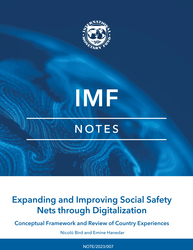
Expanding and Improving Social Safety Nets Through Digitalization: Conceptual Framework and Review of Country Experiences
Digital technologies can be vital in supporting the expansion of SSNs worldwide. Governments need to do three things: identify, verify, and pay. This note explains how countries can make improvements across these three dimensions despite differences in capacity levels.
READ MORE...
Volume/Issue:
Volume 2023
Issue 007
Publication date: December 2023
ISBN: 9798400257940
$5.00
Add to Cart by clicking price of the language and format you'd like to purchase
Available Languages and Formats
| English |
Prices in red indicate formats that are not yet available but are forthcoming.
Topics covered in this book
This title contains information about the following subjects.
Click on a subject if you would like to see other titles with the same subjects.
Economics- Macroeconomics , Economics / General , social safety nets , digitalization , COVID-19 , fiscal sustainability
Summary
Social safety nets (SSNs) are focal policies that support poor and vulnerable households, most prominently through cash transfers. However, strong discrepancies persist across countries in terms of spending, coverage, and targeting of SSNs, with larger gaps often found in low-income countries. Digital technologies can prove vital in supporting a rapid expansion of SSNs around the world. Governments need to do three things for this: identify, verify, and pay. This note explains how countries can make considerable improvements across these three dimensions despite differences in capacity levels. It examines six case studies of countries―Brazil, Democratic Republic of Congo, India, Pakistan, Togo, and Türkiye―that used and adapted digital technologies in different ways due, in large part, to variations in digital SSN infrastructures in place before the onset of COVID-19. These case studies illustrate how (1) innovative digital technologies can help overcome lack of government capacity to implement SSNs, even in countries with a lack of digital infrastructure or capacity, and (2) countries with stronger digital infrastructure or investments in SSNs before COVID-19 were able to complement existing policies to reach more people and to provide stronger responses than countries without preexisting SSN frameworks.
Copyright © 2010 - 2025
Powered by:
AIDC



